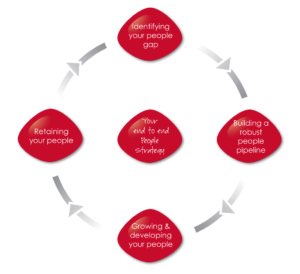
My blog this week continues to explore the topic of ‘People’.
Not least because it comes up time and time again as one of the greatest opportunities but also one of the greatest challenges when leading a business, but also because there are so many angles to cover that one blog just couldn’t do it justice.
You see the end-to-end lifecycle of a people strategy includes a number of component parts…

… with the first stage, identifying your people gaps, focused on the practical steps you can take to STRATEGICALLY rather than tactically approach this task.
The next stage, building a robust people pipeline or more specifically building a pipeline of promising performers is the focus for this week’s blog, plus check out why you should hire for attitude not skill. The latter two stages, growing and developing your people and ultimately retaining them I’ll cover over the coming weeks.
Defining talent in your business
Now the starting point is to have the mindset of ‘always be recruiting and developing people and talent’.
Sounds obvious, I know.
But in order to deliver accelerated, sustained, and profitable business growth, your people strategy has to be fluid and agile. You must be able to move internal talent around, to switch roles between people, and identify the future gaps so you can start to recruit this additional talent today.
To build a people pipeline, this process must be happening all the time.
To build a pipeline of promising performers, you must first define what talent looks like, feels like, and acts like in your business.
Most people challenges come about because the wrong people are in the wrong roles.
This can occur for a number of reasons: a skills gap, poor behaviours, a bad attitude, lack of desire or will to develop further and grow with the business, misalignment in personal and business values, or a disconnect between an individual and their line manager.
In fact, the last two reasons are actually two of the top three reasons why people leave organisations.

Ownership of some of those challenges lies with the individual, but the majority lie with the organisation itself. The business leaders have not clearly articulated what excellence looks like for a particular role and end up recruiting the wrong people into the business, and we all know the impact that can have.
The right people in the right role can accelerate your journey exponentially. The wrong people can set you back 12 months in a heartbeat and be an expensive lesson both in terms of real cash and missed opportunities.
The solution is not complicated.
Simply define the type of person who will thrive in your business.
And I have just the model that can help you with that…
Build a pipeline of promising performers; focus on the 2Ps . . . Performance and Potential
Talent is about an individual’s performance combined with their longer-term potential.

In terms of performance…
…the WHAT is about whether an individual functionally gets the job done and how well they do it.
..the HOW is whether they are living the Values, demonstrating the right behaviours, and being role models for their colleagues.
In terms of potential…
…CAPABILITY is about whether an employee is able to grow at the required pace. Some employees reach a ceiling in terms of their capability, where others continue to stretch and grow.
…ASPIRATIONS refer to whether employees have the desire and will to want to grow, to better themselves and fast track their career.
It’s probably obvious that employees with neither performance nor potential will not last very long and they’re the wrong people to have in any business. People with performance and potential on the other hand, may be the future stars of the organisation.
But what about employees that have one in abundance, but not the other?
Put simply, you need to take stock of where your people opportunities and challenges are today so that you have a clear line of sight as to where you direct your energies tomorrow and the day after!
Take stock of your people
Most people have heard or used Pareto’s 80/20 rule in business development and sales as a tool for analysing which customers contribute the majority of sales and profits. A second application is for identifying and unlocking your people talent.
Here’s how it works:
20% are top performers, 70% are the heart and soul of your business and 10% are disruptors.

Experience tells me most leaders get drawn into spending a dis-proportionate amount of time in the 10% category. Just like the bottom 10% of customers in the Pareto sales example who contribute the least profit and are the most problematic, so are the disruptors.
There’s no sugar coating this – most of the time the people who fall into this category are just not right for your business. If you have a business with clear performance expectations and a systematic review process – then the people in the bottom 10% know who they are.
A business has no spare seats and there are no free rides; seats or roles need to be filled with the right people, doing the right things, at the right time, and in the right way.
The toughest part for leaders is adjusting their leadership style according to the three categories. How you lead and manage a top performer will be completely different from how you lead and manage a disruptor.
The 20% of top performers

The challenge with top performers is that they coast in fifth gear. The exciting opportunity is that they always have reserves in the tank and can easily find sixth gear.
The top 20% are probably team members who deliver consistently year on year. They need little management – you set the goals, point them in the right direction, and they’re off.
They have a great attitude, are self-motivated, and know precisely what they need to do in order to exceed their targets and goals. If you need quick wins or to squeeze more results from the team, the top 20% are the people who’ll rise to the challenge.
Contact with your top 20% is key – not focusing on the specifics of what they are doing – just communicating with them, keeping them updated and informed and, most importantly, giving them the praise and recognition they desire. There is no mistaking the stars of a company. They are the best and are treated that way.
The 70%: your heart and soul

Managing the 70% is about identifying people with potential to move up, and cultivating them. Everyone in the middle 70% needs to be inspired and made to feel they belong. The 70% is where the majority of your time and effort should be spent and where you’ll see the greatest returns.
The 70% represent a significant percentage and applying Pareto’s principle specifically to this category gives you a further level of worthy insight:
• 20% of the 70% are future top performers
The heart and soul of your team are enormously valuable to your business – 20% of these have the potential to be your future top performers. What are you doing to identify, nurture, and develop this talent pool?
A word of caution: keep your eye on the future top performers to prevent them from becoming sliders. During the course of the year you might see differential performance as their motivation levels fluctuate or external distractions dilute their focus and drive. Spotting this is key as leader and coach. Knowing when you need to invest quality time to refocus and get them back on track is essential.
• 40% of the 70% are the heart and souls
The 40% heart and souls will deliver results. They need managing more closely, training, regular contact, focus, and tactful goal setting – but they’ll either hit or get close to their objective and goals.
• 10% of the 70% are potential disruptors
Watch out for the 10% of potential future disruptors. The people who do just enough. You question their attitude, commitment, and values. Do they really want to be here? Do they really want to be part of a team?
Finally, apply the traffic light system
Now, having applied the two P’s model (Performance and Potential) to your people, the final step you can take is to overlay the traffic light system on your findings;

GREEN reflects your top performers based on both performance and potential.
AMBER reflects the right person in the right place that might need developmental help, or the right person in the wrong place, who might have an excellent attitude, but whose skills could be better utilised in another role within the business.
RED reflects the wrong person for the organisation on both performance and potential.
Apply the 2P’s model, adopt the traffic light system and it will give you a clear picture of where;
- your developmental efforts should be applied,
- your people potentiality lies,
- your people gaps are.
I promise you, it will help you build a pipeline of promising performers.
Share your comments below, especially if you use any other strategies or tools which help you build your people pipelines, I’d love to hear about them.

